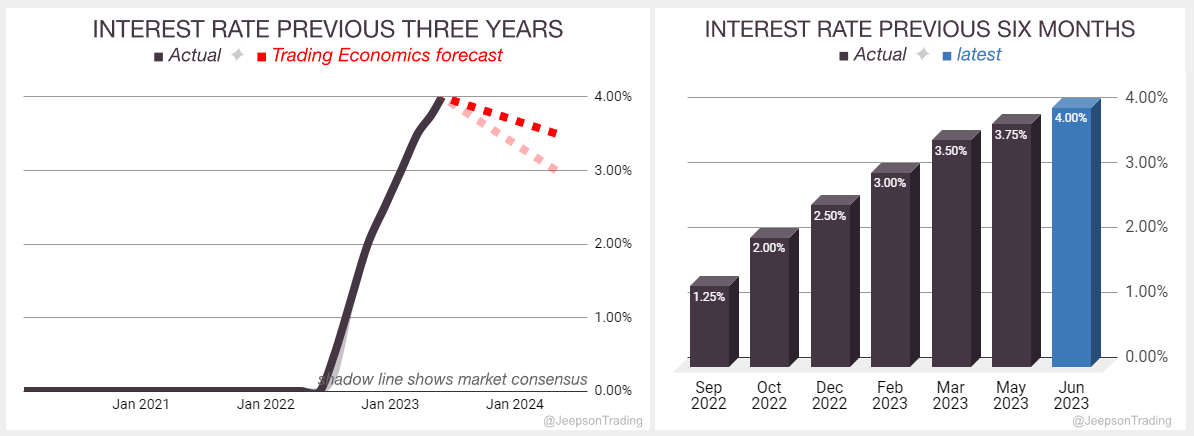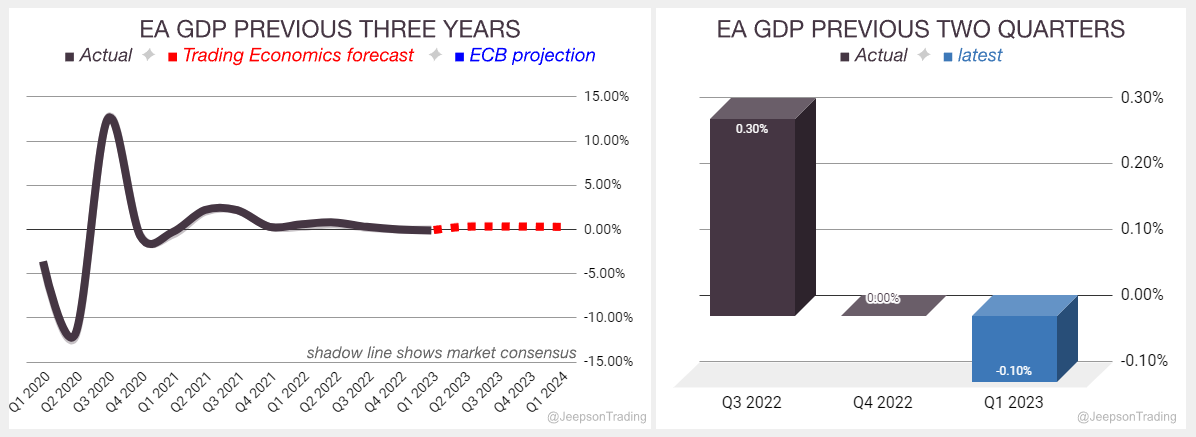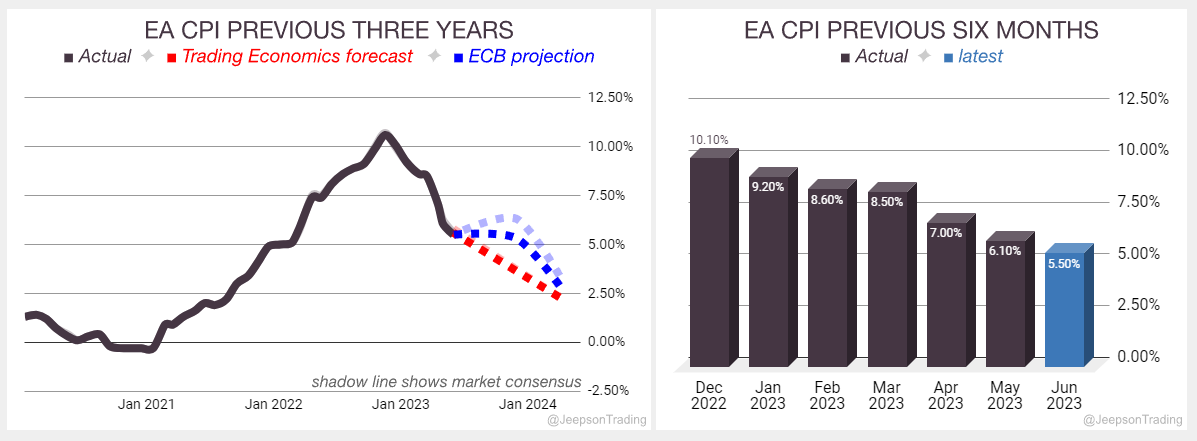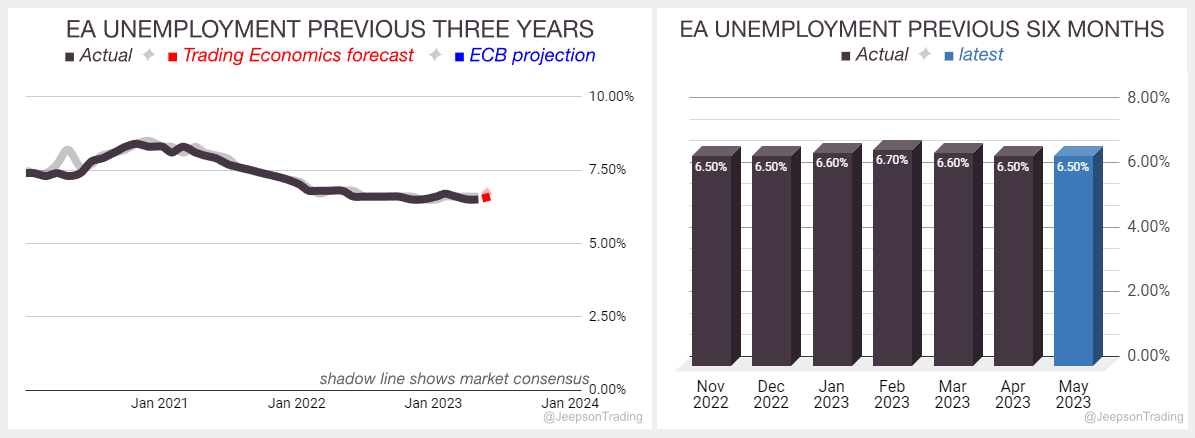Euro Forex Reference JULY
This is the Euro Forex Reference and contains factual information that has been researched from official sources as well as market commentators. It is intended to be used as a guide to aid in your analysis.
DERBYSHIRE GB / JULY 25th, 2023 - Updated with final CPI report. Next update after the ECB meeting on Thursday the 27th of July, or before if any significant event occurs.
ABOUT
The euro is the currency of the European Union. It was introduced in 1999 and is now used by nineteen of the twenty-seven EU member states. The euro is the second-largest reserve currency in the world and is the most traded currency after the US dollar. It is a symbol of European unity and is seen as a sign of economic stability.
MONETARY POLICY
The European Central Bank
In the Euro Area, the benchmark interest rate is set by the Governing Council which consists of six members from the Executive Board plus governors of the national central banks from the nineteen countries using the euro.
June Meeting of the European Central Banks, Governing Council
The Main Refinancing Operations rate was hiked by 0.25% in June to 4.00%, matching the 0.25% hike in May
This was as expected by analysts
This was the eighth consecutive rate hike since this cycle began last year in July 2022
Trading Economics have retained their Q2 2023 Main Refinancing Operations Rate forecast at 4.00%
The interest rate in the euro area (EA) has increased from 0.00% to 4.00% over the past three years, with the rate of increase accelerating in the past six months. Trading Economics expects the interest rate to remain near current levels this quarter. However, the ECB has signalled that higher rates are likely this year.
The next meeting is on Thursday the 27th of July
The Governing Councils June statement contained cautiously optimistic sentiment and a data-dependant approach to monetary policy:
Rates raised by 25 basis points to combat high inflation, which is expected to remain high in 2023 but fall in 2024.
Economic growth to be slightly lower than previously forecast as the hikes are having a cooling effect.
The pace of rate hikes will depend on economic data but will continue to be raised until inflation falls to 2%.
The ECB will stop buying bonds under its asset purchase program in July 2023.
Sources: European Central Bank, Macroeconomic Projections, Trading Economics, FXStreet
Macroeconomic Projections
The Governing Council revised its macroeconomic projections at their June meeting. They will update them again in September.
Economic activity is expected to slow in 2023, but to rebound in 2024 and 2025.
Inflation is expected to remain high in 2023, but to decline in 2024 and 2025.
The main drivers of economic growth are expected to be:
strong labour market, unemployment hitting new historical lows
rebound in foreign demand
resolution of supply chain bottlenecks
The main drivers of inflation are expected to be:
higher energy prices
tighter labour markets
higher unit labour costs
ECONOMIC DATA
Gross Domestic Product (GDP)
In the US, GDP Growth Rate measures the yearly change in the price of goods and services purchased by consumers.
GDP Growth Rate Third Estimate for Q1 2023
GDP in the EA for Q1 slowed to a 0.1% quarterly contraction from 0.0% in Q4 2022
Lower than the 0.00% expansion expected by analysts
The euro area economy is expected to slow down in 2023, but inflation will remain high
The June Governing Council macroeconomic projections for the 2023 Real GDP was lowered to a 0.9% expansion from 1.0% which was projected in March
Trading Economics have lowered their Q2 2023 annualised growth forecast to 0.3% from 0.4%
Over the previous three years, GDP has climbed steadily from a low of -4.3% in Q1 ‘21 to a high of 14.6% in Q3 ‘21. However, it has been falling for the past six months to a recent low of 1%.
The flash Q2 report is due on Monday the 31st of July
Sources: Eurostat, Trading Economics, FXStreet
CONSUMER PRICE INDEX
Measures the yearly change in the price of goods and services purchased by consumers using the weighted average of the Harmonised Index of Consumer Price (HICP) aggregates.
Final CPI for June
CPI in the EA for June slowed a lot to 5.5% annual inflation from 6.1% in May
This was as expected by analysts
The slowing rate was driven by a fall in energy prices that deflated 5.6% from 1.8% last month
The June Governing Council macroeconomic projections for HICP in 2023 slightly raised to 5.4% inflation from 5.3% which was projected in March
Trading Economics have Q3 2023 CPI forecast at 4.7%
Over the previous three years CPI has rapidly climbed from a low of -0.3% in Jan ‘21 to a high of 10.6% in Nov ‘22. However, it has been falling for the past six months to the recent low of 5.5%.
The flash July report is due on Wednesday the 31st of July
Sources: Eurostat, Trading Economics, FXStreet
LABOUR
Measures the number of people actively looking for a job as a percentage of the labour force.
Labour Report for May
Unemployment in the EA for May remained at 6.5%, the same level as April
This was as expected by analysts
Trading Economics have retained their Q2 2023 unemployment rate forecast at 6.6%
Over the previous three years, unemployment has fallen from a high of 8.3% in Mar ‘21 to a low 6.5% in May ‘22. This fall has stabilised in the past six months.
The June report is due on Tuesday the 1st of August
Sources: Eurostat, Trading Economics, FXStreet
MARKET NARRATIVES
Russia–EU gas dispute
The Russia-EU gas dispute has caused an increase in the cost of energy which has reduced the spending power of consumers and resulted in slower economic growth. This is likely to lead to reduced foreign investment in the stock market and is expected to apply downward pressure on the Euro’s value.
The EU imported 83% of its natural gas in 2021, with 50% of that coming from Russia. However, after Russia invaded Ukraine in March 2022, the EU needed to diversify its gas imports and seek out more reliable suppliers.
The global energy market is likely to become more volatile in the years to come, due to a number of factors, including the increasing demand for energy from developing countries, the growing importance of renewable energy, and the uncertainty surrounding the future of fossil fuels. Europe is debating how to separate gas prices from electricity prices so that consumers are more protected from the volatile price of gas, which has been a major driver of rising electricity prices.
2022: In the wake of Russia's invasion of Ukraine, Russia began demanding that its natural gas customers pay in rubles, rather than euros or dollars. This led to a number of European countries, including Poland, Bulgaria, and Finland, refusing to pay, and subsequently having their gas supplies cut off. Russia also cut off gas supplies to Ukraine, which was a major transit point for Russian gas to Europe. These events have had a significant impact on the European energy market, causing gas prices to skyrocket and raising concerns about energy security.
GEOPOLITICAL EVENTS
Russian Invasion of Ukraine
The war is having a detrimental effect on the global and EA economy by causing higher energy prices, supply chain disruptions, financial market volatility, refugee crisis and geopolitical uncertainty.
2021: 92,000 Russian troops are amassed at the Ukraine border and President Putin proposes a prohibition of Ukraine joining NATO which is rejected.
2022: On the 21st of February, President Putin ordered Russian forces to enter the separatist republics in eastern Ukraine and announced recognition of the two pro-Russian breakaway regions (Donetsk People's Republic and Luhansk People's Republic). NATO applied sanctions and scaled them up as the war progressed. Ukraine mounted a counter-offensive which regained lost territory and as winter arrived, a stalemate began.
2023: Russian began a new offensive in January although gained little ground. In early June, Ukraine began its counteroffensive although progress has been slow even as Russia faced mutiny from the short-lived Wagner rebellion.
Gavin Pearson
Retail trader since 2008
Specialises in forex G7 currencies
Funded account from the5ers.com
Member of the eToro Popular Investors Program
Regular contributor to FXStreet.com analysis and education pages
Jeepson Trading Fund
Returned 27% in 2022 and 5.8% in 2023 H1
Forex focused
Copy Trading available at eToro
eToro
eToro is a social trading platform
Users can copy trades by clicking the "Copy" button on the profile page
Disclaimer
Past performance is not indicative of future results
Trading involves risk, and you could lose money
-end-







